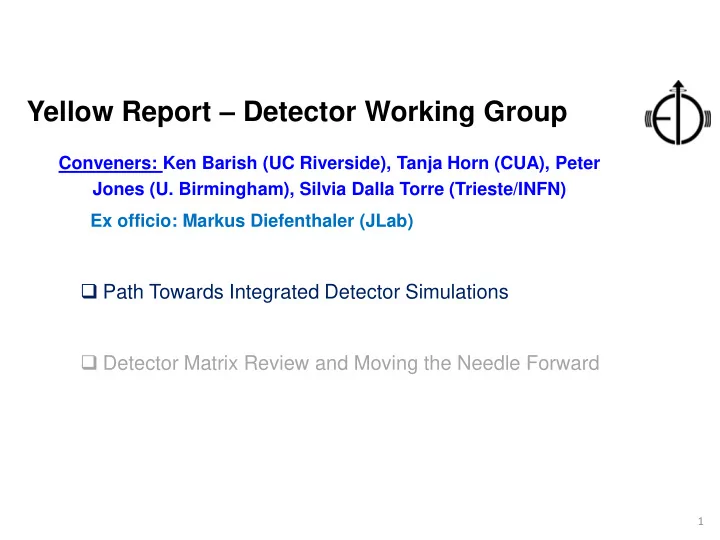

Yellow Report – Detector Working Group Conveners: Ken Barish (UC Riverside), Tanja Horn (CUA), Peter Jones (U. Birmingham), Silvia Dalla Torre (Trieste/INFN) Ex officio: Markus Diefenthaler (JLab) ❑ Path Towards Integrated Detector Simulations ❑ Detector Matrix Review and Moving the Needle Forward 1
Path towards Integrated Detector Simulations Cartoon/Model of the Extended Detector and IR For this discussion focus on the example of the Central Detector ➢ Status of simulations for Tracking, Particle ID, and Calorimetry 2
Tracking simulation activity summary Overview: • working on the main deliverables: ✓ evaluate all-silicon vs hybrid (silicon & gaseous) trackers ✓ compare realistic alternatives (TPC, MPGD options) for gaseous detectors, barrel and forward • baseline performance studies (mainly EicRoot-based) available at Pavia: ✓ central region Si-vertex + TPC + Fast MPGD Layers ✓ endcap region GEM (MPGD) trackers ✓ all-silicon (barrel) tracker + forward/backward silicon disks ✓ comparisons all-silicon vs BeAST (Si-vertex + TPC + MPGDs) concepts • recent (increasing) effort within Fun4All simulation framework: ✓ implementation of all-silicon tracker ✓ moving all-silicon layout studies from EicRoot to Fun4All new since Pavia ✓ replacing TPC with MPGD layers ✓ first implementation of Forward Silicon Tracker (FST) • main available results: ✓ momentum/angular and pointing resolutions in different configurations/options 3
Tracking simulation activity summary Further details on the recent effort within Fun4All: ✓ implementation of all-silicon tracker: ▪ detailed geometry study (eg material scan to understand features of X/X0 plot) ▪ comparison of uniform to realistic B-field (performance compared with BeAST and sPHENIX maps) ▪ first studies of jet reconstruction performance (ongoing) ✓ moving all-silicon layout studies from EicRoot to Fun4All: ▪ managed to export geometries from EicRoot to Fun4All (via GDML) ▪ all-silicon layout studies compared: no significant difference between the two frameworks ▪ simulation of physics events to be propagated/reconstructed through different layouts (ongoing) ▪ plan to check performance on benchmark signals (eg D0 invariant mass reconstruction) ✓ replacing TPC with MPGD layers: ▪ improved tracker geometry with more realistic material (carbon fiber supports, PCB r/o boards etc) ▪ new material budget scan performed (still within requirements) ▪ performance (momentum/angular resolutions) re-checked, no significant degradation ▪ preliminary simulation of uTPC mode (to be refined) ✓ first implementation of Forward Silicon Tracker (FST): ▪ 6 FST planes (including 2 time-stamping planes) integrated with 3-layer Si barrel in the Babar magnet ▪ preliminary performance at different pseudorapidity vs pixel cell size and sensor thickness ▪ geometry and detector configuration to be optimized (ongoing) 4
Particle ID simulation activity summary 5
Particle ID simulation activity summary 6
Calorimetry simulation activity summary 7
Calorimetry simulation activity summary 8
Path towards Integrated Simulations ❑ Simulations including Geant4 available for all regions of the central detector ➢ Simulations also available for forward/backward detectors ❑ Next step towards integrated simulations is to merge the individual detector simulations into one of the existing tools ➢ Make your simulation code available on the GitHub organization of the EIC: https://github.com/eic ➢ Instructions on how to integrate standalone simulations into the existing EIC framework can be found on the SWG GitHub: https://eic.github.io/ ➢ Additional information on the existing tools: ESCalate: https://www.youtube.com/watch?v=-wAI9kWoLCs Fun4All: https://www.youtube.com/watch?v=fONXYf7lsP0 EicToyModel: https://github.com/eic/EicToyModel 9
Recommend
More recommend